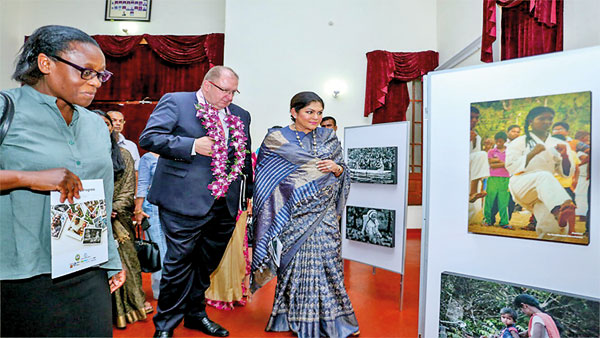Fastest-growing South Asia expected to grow further, WB official says
The South Asian region is the fastest growing region in the world where growth has been strong. Eight countries in the region have recorded 6.9 per cent growth which is expected to exceed 7 per cent next year, said Dr. Hartwig Schafer, Vice President South Asia Region of the World Bank.
The visiting official, speaking at the Colombo launch of the Sri Lanka Development Update on “Demographic changes in Sri Lanka” last week, said however that behind the strong growth of these countries, the darker side of it was due to debt dynamics, growing fiscal deficits and widening current account deficits.

World Bank Vice President South Asia Hartwig Schafer (centre), Mayor of Colombo Rosy Senanayake (right) and World Bank Country Director for Sri Lanka Idah Pswarayi-Riddihough (left) launching the exhibition and awards of the photography competition to press for progress to create the space for women to access and remain at work in Colombo. (Picture courtesy World Bank).
“Should there be a global economic shock this growth can be very fragile and we need to keep our eyes open to have preventive measures in place,” he cautioned.
Dr. Schafer said that three out of five countries in South Asia are most vulnerable to climate change and natural disasters. Eighty per cent of the big cities of the metropolis in South Asia is floods-prone and Colombo for instance was badly affected by floods a few years back. One of the projects of the World Bank is to prevent such floods happening and to prevent loss of life and help prevent damages caused by floods amounting to hundreds of million of rupees per year. “Having visited Sri Lanka after many years I have witnessed Sri Lanka’s tremendous progress and potential for economic development where the World Bank provides resources, policy advice and technical assistance.”
He said multi- dimensional poverty has to be looked into in terms of access to education and services and South Asian countries stands lower than the rest of the world. ”We have to intervene with regard to develop human capital and improve access to services. Sri Lanka is one of the top performers in the region, but more has to be done to improve human capital.” Referring to the huge debt burden the country faces, he said the World Bank has some proposals to help Sri Lanka.
The opening up of the private sector is important for foreign investment to flow into the country. The World Bank will work closely with the Sri Lankan government to create regulatory policies to encourage private sector participation in development activities. Sri Lanka has done extremely well in the international ranking moving upwards. “The World Bank has 14 projects under implementation in Sri Lanka to the tune of US$1.8 billion covering a range of sectors from infrastructure, agriculture, flood mitigation, water and macroeconomic management systems.”
Senior Country Economist for Sri Lanka and the Maldives Dr. Fernado also spoke. The panel discussion on demographic change in Sri Lanka involved State Minister, Ministry of Finance and Mass Media, Eran Wickramaratne; Dr. W.A. Wijewardena former Deputy Governor of the Central Bank; Prof. Indralal de Silva, former (chair) of Demography, University of Colombo; and Prof. Amala de Silva, Department of Economics, University of Colombo.
| Reducing gender gap boosts Sri Lankan economy World Bank Vice President for South Asia Region, Hartwig Schafer concluded a three-day visit to Sri Lanka on Friday with a commitment to work with public and private sectors to create the space for women to access work and remain at work. Evidence suggests that Sri Lankan women are excelling in higher education and outlive men, but they are not part of the workforce. This comes at great cost to economic growth, he said according to a media release issued by the World Bank. During the visit, Vice President met with the President Maithripala Sirisena, Prime Minister Ranil Wickremesinghe, Minister of Finance Mangala Samaraweera, State Minister of Finance Eran Wickremaratne, Mayor of Colombo Rosy Senanayake and Central Bank Governor Indrajit Coomaraswamy. He also interacted with community groups, project officials, private sector, development partners, civil society groups and completed a field visit to learn about a planned project to mitigate flood risk in Colombo. On the last day of his visit, he participated in an exhibition and awards ceremony for female photographers at the Colombo Municipal Council. “Getting more women into jobs is not only a development imperative, but there’s also a strong business case,” said Mr. Schafer highlighting Sri Lanka’s achievements in human capital development and economic growth amidst challenges and risks. “Sri Lanka specifically could grow its economy by as much as 20 per cent in the long-run by closing the gender gap in the workforce,” he emphasised quoting data from an IMF study. During meetings with the PM, Minister of Finance and the Central Bank Governor, Mr. Schafer discussed the Government of Sri Lanka’s reform agenda. He congratulated the Government’s achievements in reforms and moving up to the top 100 rank in the Doing Business index. | |


